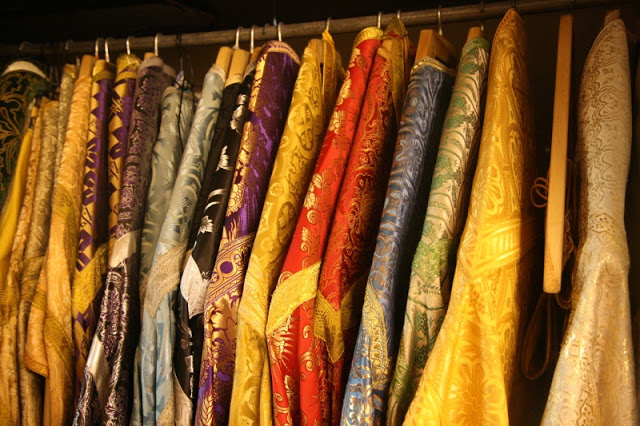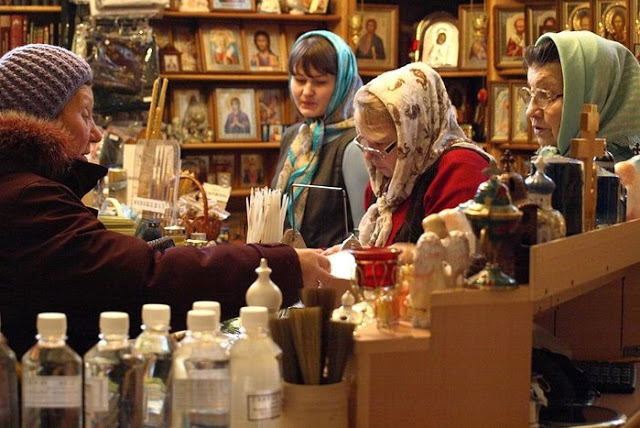
I love the change of liturgical colors because it helps mark the seasons with a different focus so quickly and beautifully. But one in Orthodox churches we run into such variety about what color is used for what season or feast it seems confusing. Well, it is confusing, sort of anyway.
Before the fourteenth century no Christian church had assigned colors for seasons, fasts or feasts the way we understand them now. There was only a very broad guideline. In the Orthodox Church the colors are specified in what is called the Typikon, but in the Typikon there are only three colors called for: general, dark and bright. That’s as specific as it gets. General is taken to mean gold. Dark is often thought of a purple (but can be red, burgundy, or even black). Bright is white but historically could also simply mean one’s nicest or most beautiful set.

So where did all of these colors come from? In the early 1500s the Roman Church came upon a set pattern of colors and seasons. They used five colors: white, red, green, violet, and black — although Spain was allowed to use blue as well. The Orthodox Church saw the use of colors used in the West and adopted (and altered) that pattern. This is usually thought to have come through Russian and perhaps from Czar Peter the Great’s experience with the West. But the adoption in the Orthodox Church was not uniform and the old Typikon still stands. Even different areas of Russia have slightly different customs for liturgical colors.
To make the even more confusing, as Antiochians, we have adopted the Russian pattern and altered it, and again we are not uniform in our use of colors either. One custom is to always use gold on Sundays, even in fasts, because Sunday is the day of Resurrection. Neat idea, but honestly 90% of our parishioners would never see a different color being worn, so that is not a very common custom. Bishop BASIL of Wichita gave a pattern for the clergy of the Diocese of Wichita and Mid-America which represents a common pattern for us and many clergy simply use his table. I myself use a modified form of it.

And yet there are new things happening still. I say new things but they aren’t really. Many people “know” that we wear violet/purple for Lent. That has been pretty standard now for over a hundred years in the US. But now we are beginning to see the use of burgundy too. The issue there is that violet/purple was not a set color until the 19th century with artificial dyes and could vary widely. Burgundy is a very ancient color that is “dark” and was used for Lent, so it’s not really a new thing.

A common pattern that I am familiar with is:
– Gold is for general seasons; a bright or metallic gold can be for feasts.
– Red is for the Cross and Martyrs.
– Red/burgundy is used for the Nativity Fast (Advent).
– White is for Christmas/Theophany/Pascha (Easter) and for Saints who were not martyrs.
– Violet/burgundy is for Lent. Sometimes black is used for weekdays of Lent leaving the Sundays for violet/burgundy.
– Black can be used for Holy Week and funerals outside of the Paschal season.
– Blue is used for the Theotokos and ever-Virgin Mary.
– Green is used for Pentecost.

There are many variations to that pattern and none of them is absolutely correct because in reality the Typikon is still the “official” guide and there it speaks of only three colors. As confusing as all of this is, the change of colors really does mean something. The emphasis of the Church’s liturgical life is moving and it’s wonderful that the Church allows our eyes to see it quickly.

It is not only the priest and deacon’s vestments that change color, but also the altar coverings and the altar servers’ vestments. This makes a very dramatic impact. It is also expense to change all of the servers’ vestments. Some parishes have all of the colors for the servers’, others only have gold, white, red, purple and blue, others have fewer. But it ought to be a real goal of parishes to provide as many of these colors for the servers’ as they can afford. It really does make an impact.
So thank God that we make use of colors to teach and draw attention to our liturgical year. We are truly blessed.




